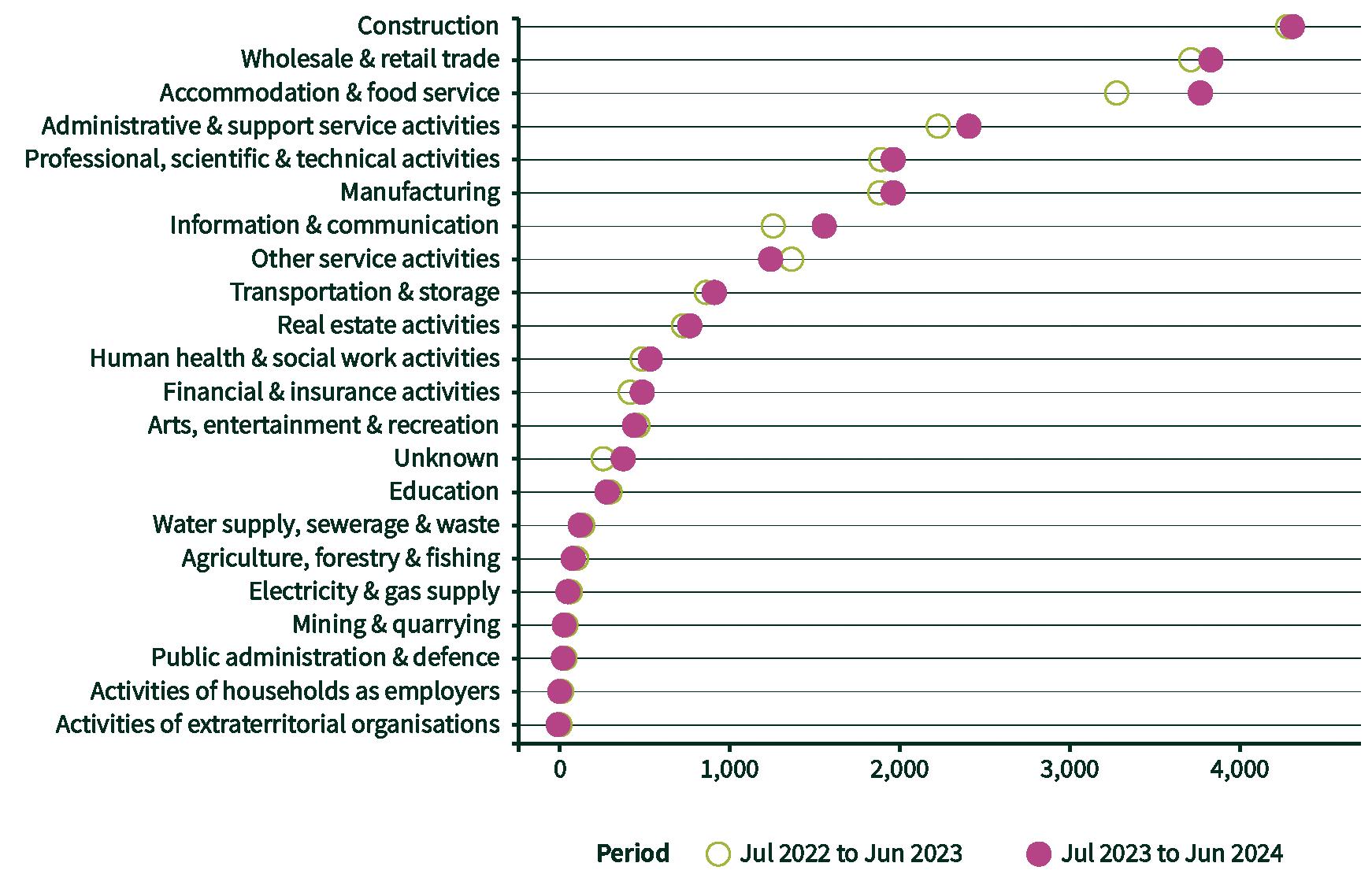











Unsecured
Secured
Business
















KIERAN
33 Eastcheap | London | EC3M 1DT Kieran.Jones@nacfb.org.uk
JENNY BARRETT
Communications Consultant Jenny.Barrett@nacfb.org.uk
LAURA MILLS
Communications Manager Laura.Mills@nacfb.org.uk
SOPHIE OLEJNIK
Digital Marketing Executive
Sophie.Olejnik@nacfb.org.uk
MAGAZINE ADVERTISING
T 02071 010359
Magazine@nacfb.org.uk
MACKMAN
Design & Production T 01787 388038 mackman.co.uk






Norman Chambers Managing Director | NACFB
Welcome to this year’s final issue of Commercial Broker magazine and what will also be my final introductory note in these pages. At this stage, I find myself reflecting on the journey we’ve all been on together. I’m not one for being overly sentimental and lengthy goodbyes, so I’ll keep this simple.
After years serving as the NACFB’s managing director, I’m stepping back from that role and assuming a position as a non-executive director on the trade body’s Board. Whilst this change marks the end of one chapter for me, I won’t be far from the trade body that has meant so much to me over the years. You’ll still see me around, perhaps at an upcoming industry event, as I remain committed to supporting our shared goals.
Above all else, I am proud. Proud of what we’ve achieved together as an Association, proud of the connections I’ve had the privilege of forging, and incredibly proud of the team we’ve nurtured within the NACFB. Watching this organisation grow into the thriving, dynamic body it is today has been one of the greatest honours of my career.
I also want to take this moment to welcome Jim Higginbotham, our incoming CEO. Jim’s leadership will undoubtedly guide the Association into an exciting new phase, and I look forward to seeing what’s next under his stewardship.
Thank you for the support, friendship, and collaboration over the years. It’s been a privilege to serve, and I’m excited for the future.


Association update

Experienced commercial finance leader to guide trade body’s next chapter
The NACFB has appointed Jim Higginbotham as its new Chief Executive Officer (CEO). With more than 30 years of experience in the commercial finance industry, Jim brings a wealth of knowledge to the leadership role.
Jim most recently served as Group CEO at STAR Asset Finance, where he led the brokerage through a period of substantial change, enhancing the risk control framework, upgrading the IT infrastructure, centralising the core business functions across four previously independent brokerages and increasing the group balance sheet by 50%. He has previously held senior roles at Lombard, Barclays, and GE Capital, where he developed an extensive understanding of asset finance, risk management, and stakeholder engagement across a variety of financial sectors.
In his first statement as CEO, Jim Higginbotham said: “I am honoured to have been chosen by the NACFB Board to lead the Association into its next chapter of development. With over three decades of experience across all areas of commercial finance, I feel well placed to represent and deliver against the needs of our Members and Patrons. Over the last ten years, the importance of the commercial finance broker in the UK’s financial ecosystem has continued to increase. For more and more UK SMEs, our Members act as trusted business partners, unlocking access to the most appropriate finance solutions, independent of product or provider.”
Adrian Coles, Interim Chair of the NACFB, welcomed Jim’s appointment, stating: “Jim was a standout choice for the NACFB Board. His experience, leadership, and vision make him the ideal person to guide the Association into the future. We are confident that Jim will build upon solid foundations, confidently steering the NACFB whilst ensuring
it remains at the forefront of the intermediated business finance sector. The Board and I look forward to working closely with him as we navigate the challenges and opportunities that lie ahead.”
As Jim assumes his new role, Norman Chambers, who has played an instrumental role in the trade body’s success, will transition to the position of Non-Executive Director on the NACFB Board later this year. Norman’s tenure has been marked by record-breaking membership growth and a strengthened reputation for the trade body within the industry.
Jim is stepping into the role at a pivotal time for the NACFB, which earlier this year surpassed the milestone of 1,300 Member firms.

From refreshingly simple term loans to lines of credit and our brand new Cashback business credit card, we’re here to offer the finance options that back your clients to succeed.
Secured and unsecured loans
Lines of credit
Short-term funding








Less can be more when helping SMEs find the money for growth
Dave Furnival Head of Broker NatWest
t’s a long time since the UK was called a nation of shopkeepers. In fact, hundreds of years if indeed Napoleon said it first. But a recent Forbes Advisor poll reported that 41% of Brits would like to start their own business one day. And when they take the vocational plunge, they’ll join the 5,547,000 companies that qualify as either small or medium businesses (99.05% of the total).
However, circa 26% of those wanting to start a business say they need the conditions to be right first. As the UK has danced with both recession and recovery over the past year or so, we know that finance is vital to supporting smaller businesses, whether they are recent start-ups or not.
That’s why we’re committed to boosting economic growth across the whole country, and this is why we’ve made it quick and easy for businesses of all sizes to use Broker Direct.
In August we increased the limit on how much businesses can borrow through our Broker Direct service: up from £250,000 to £500,000. Broker Direct launched last year and the high demand has meant that businesses can now borrow more through it.
For the uninitiated, Broker Direct is a dedicated service for SME brokers and has grown significantly in demand since its launch
in June 2023. Since then, the time taken from the deal being presented to a credit backed decision has reduced by 35%.
NatWest is the only UK high street bank to offer such a service, and it demonstrates the bank’s commitment to SMEs and overall UK economic growth.
Aside from helping brokers to successfully secure credit backed decisions for their clients quicker than ever before, Broker Direct also keeps them up to date at every stage of the lending cycle.
So we are now able to support brokers with lending opportunities from £50,000 – £500,000. We do this when other high street banks are rowing back on the smaller amounts available to brokers, disadvantaging smaller businesses. However, NatWest is the UK’s largest business bank and is committed to helping small businesses to scale, so will continue to offer smaller sums through its broker portal. The lower limit of borrowing through Broker Direct is £50,000.
In short, we’re happy that Broker Direct has seen such high demand and we'll continue to work closely with customers to help them grow and get to where they want to be.
Today SMEs in the UK have a combined turnover of £2 trillion – which is 52% of turnover in the private sector. Let’s support the little guys. We need them and they need us.

Development
Commercial
Bridging
Residential
Secured



1. Business confidence takes a hit
Research from the Institute of Chartered Accountants of England and Wales (ICAEW) has revealed a decline in business confidence, which fell to 14.4 in Q3 2024, down from 16.7. This marks the first decrease in a year, although confidence remains double the pre-pandemic average. The drop is largely attributed to rising concerns over the tax burden, with 29% of firms citing it as a major issue. Alan Vallance, CEO of the ICAEW, said: “This drop in confidence suggests that businesses are still cautious about the future.”

2. Manufacturing growth slows amid uncertainty
The UK’s manufacturing sector experienced a slowdown in growth, with the S&P Global UK manufacturing PMI survey recording a reading of 51.5 for September, down from 52.5 in August. Despite factory output rising for the fifth consecutive month, confidence has plummeted to a nine-month low. The decline in optimism is attributed to uncertainty surrounding the upcoming October Budget and broader global economic concerns. Input cost inflation has also surged to a 20-month high, prompting manufacturers to increase selling prices.

3. Barriers to innovation investment revealed
New research by ForrestBrown reveals that UK businesses are keen to invest in innovation but face significant barriers. A shortage of skilled personnel is a major concern, with 19% of businesses citing it as a key issue. The Learning and Work Institute predicts a shortfall of 2.5 million skilled workers by 2030, costing the UK £120 billion. Financial and regulatory constraints also hinder investment, with 20% of leaders struggling to secure funds and 23% facing regulatory challenges.
Property sales company Upstix, which claims to help customers sell homes in seven days for 85% of their market value, said it had seen inquiries jump 41% from August. The mood is reflected in research by the National Residential Landlords Association, whose campaigns and policy director, Chris Norris, said: “Our advice to landlords is to keep a calm head. There is a lot to consider from the point of return on investment and the risk profile of being a landlord, but there are also still opportunities presented by high tenant demand.”
New research indicates that UK SMEs are incurring over £3,700 annually in hidden fees from financial institutions. A survey of 500 businesses revealed that 69% are concerned about potential closure due to rising costs, with 49% attributing this to increasing material expenses and 19% to concealed bank charges. Despite efforts to cut costs, 56% have had to make redundancies, with 84% considering it a last resort. The research underscores the urgent need for transparency in banking fees, which collectively amount to £2.8 billion annually.
The latest asset finance industry index from Acquis shows that the value of new equipment finance deals in the UK fell by 14% year-on-year in the first half of 2024. It was also shown that lease inceptions in H1 were behind both 2022 and 2023.
June saw the most significant drop, with a 30% decline in value of new equipment finance deals. Across the various sectors, industrial equipment was the only sector to be performing ahead of both 2022 and 2023, reporting an 8.2% increase on 2023.
Business confidence dipped by 3 points to 47% in September, its lowest for three months, but remained above the survey’s long-term average reading of 29%. The fall was led by a lower net balance for optimism regarding the economy, which declined to a six-month September 2024 low, mitigated by an improvement in firms’ own trading prospects to match 2024 highs. Prospects for employment edged down marginally, but over half of businesses nevertheless still plan to hire.


We work one-to-one with our broker partners so we understand your needs and your clients’.
Delivering an award winning service, we are committed to making things easier for you with a ‘can do’ attitude and products that fuel ambition.

Broker Sales Support: 01254 685850
Proposals: proposals@haydockfinance.co.uk


ADavid McCoubrie Head of Sales Horizon Energy Ventures
chieving net zero by 2050 is an ambitious goal that demands extensive infrastructure, energy, transportation and industry change. It will also require substantial investment, technological innovation, and widespread behavioural shifts, whilst balancing economic growth and social equity under tight time constraints. To meet this challenge, businesses must act decisively and begin implementing changes to energy sourcing and consumption.
Horizon Energy Ventures helps businesses invest in sustainable energy infrastructure through innovative funding and strategic partnership led products. We recognise that many effective decarbonising technologies require upfront investment.
That’s where we come in, offering businesses who want to adopt clean and low-cost energy technologies an alternative to upfront capital expenditure.
Our roots
We bring extensive experience to projects driving the UK’s smart meter revolution. Our sister company, Horizon Energy Infrastructure, is a key player in the UK smart meter rollout with over 15 years’ experience in the energy sector. We are backed by one of Europe’s most dynamic
independent fund managers, Arcus Infrastructure Partners, empowering us to invest in sustainable green energy ventures.
Our team of sustainable finance experts have deep expertise in finance and renewable energy initiatives. Ryan O’Connell, our head of commercial, has a proven record in implementing financial solutions for new energy ventures. His knowledge of the benefits that low carbon technologies can deliver is instrumental in tailoring our financial products and services to meet the specific needs of our UK clients. Having previously built and managed a portfolio of over 150 renewable energy projects via asset finance, and delivering many others through outright purchase options, Ryan brings invaluable first-hand understanding of the underlying assets themselves and how they are complemented by asset finance.
I lead the sales and account management team for Horizon Energy Ventures, driving the development and tailoring of our products to our clients’ diverse needs. With over 30 years’ experience in B2B finance, my experience spans some of the largest vendor finance companies.
“ We essentially help businesses decarbonise and save costs in the process

We focus on lending to UK, non-regulated businesses, offering products such as finance leases, operating leases, and utilisation-based leases in the EV charging market
Together, we are fully committed to the energy transition and believe it presents significant opportunities for businesses in the future.
We partner with infrastructure developers, consultants, and especially brokers to accelerate sustainable change through investing in low-carbon and green energy infrastructure – offering a range of flexible finance solutions for solar PV, EV charging infrastructure, low carbon and carbon-neutral heating systems, battery storage, and microgrid technologies. We essentially help businesses decarbonise and save costs in the process.
We recognise that each deal can be unique, and every opportunity requires a bespoke approach. This is why we evaluate each case individually. We focus on lending to UK, non-regulated businesses, offering products such as finance leases, operating leases, and utilisation-based leases in the EV charging market, with typical transaction values ranging from £5,000 to over £5,000,000. With access to extensive funding through our parent company Arcus Infrastructure Partners, we have the flexibility to scale as needed, ensuring we can support a wide variety of opportunities.
We recognise that certain transactions require longer term funding,
and this is where Horizon Energy Ventures can really add value to the broker offering. We offer above-market standard length terms on solutions for solar PV, EV charging infrastructure, battery and heat pumps. We can also finance the (often significant) installation costs associated with a deal – setting us apart from traditional funders. We are also excited to be able to offer an innovative utilisation-based model on EV charging infrastructure.
For governmental/local authority entities including schools, we can offer an operating lease product over a term of up to nine years on solar PV and battery storage solutions.
We have ambitious growth plans, and the broker channel is core to our strategy, especially brokers who are looking for a finance partner that specialises in low carbon technologies, energy and charging solutions, particularly within the B2B industrial, commercial and local authority sectors.
We recognise the potential of the broker market and are committed to further developing the introducer channel as a cornerstone of our strategy. Approximately 84% of all corporate UK companies are small-to-medium (SME) enterprises, making them a crucial segment of our market. As everyone strives toward net-zero targets, it’s clear SMEs will play a vital role in driving this transformation. We are actively exploring funding approaches to help achieve these ambitious goals.


IAnwesha Saha Contract Analyst NACFB
n an age where terms and conditions have become part of the fabric of everyday transactions, we rarely stop to scrutinise the agreements we enter into. How often do we actually review the fine print in our daily contracts – whether it’s a mobile phone plan or a software update? More often than not, we simply accept them without question. But in our world of commercial finance, where agreements can make or break a business relationship, it is ever vital to ensure that contracts are fair and reasonable. This is particularly true when it comes to the broker agreements between lenders and brokers that form the backbone of the intermediary-led commercial finance sector.
Here at the NACFB, one of our key roles is to stand between brokers and lenders, ensuring a fair and balanced trading environment. Such mediation work is aimed at fostering productive relationships, where both parties can focus on the right transactions for their clients without worrying about being unfairly penalised if things don’t go as planned. After all, even with the best of intentions, deals will inevitably sometimes go wrong, and it’s crucial that the terms governing such scenarios are equitable for everyone involved.
As the NACFB’s contract analyst, my task is to engage with our commercial lender Patrons and request their broker agreements. These agreements formalise the relationship between brokers and lenders and can vary significantly in terms of complexity and fairness. I make it clear that it is not my job to absolve brokers of responsibility or risk – far from it. Instead, I aim to ensure that these agreements are equitable, in line with industry standards, and free from clauses that unfairly burden brokers.

“It is not my job to absolve brokers of responsibility or risk… I aim to ensure that these agreements are equitable, in line with industry standards, and free from clauses that unfairly burden brokers
The NACFB introduced the role of contract analyst to help address a growing concern: too many broker agreements include terms that place disproportionate risk on brokers. Lenders often include clauses that require brokers to bear a greater share of the risk in the event of a transaction failure.
Many of these clauses may seem innocuous at first glance but can be onerous when enforced. Our goal is to ensure that such terms are reviewed, amended where necessary, and explained to both parties to foster a more balanced and fair trading relationship.
Often, lenders are unaware that these clauses exist or that they may be damaging their relationships with brokers. By identifying these potential pitfalls, we’re not only protecting brokers but also helping lenders build stronger, more sustainable partnerships with their intermediary panel.
In my role, I focus on several critical aspects of broker agreements that often require attention. One of the primary issues is the presence of onerous clauses – terms that unfairly transfer the burden of risk to brokers, especially when they have little control over the outcome of a transaction. For example, if a deal falls through due to factors beyond the broker’s influence, it is unreasonable to expect them to bear the full financial penalty.
Additionally, many agreements are riddled with ambiguous or unclear language, filled with legal jargon that obscures the true meaning of certain clauses. My work involves clarifying this language so that both brokers and lenders fully understand their obligations and rights. Another challenge is the absence of essential clauses that should protect both parties; a good example is the lack of a robust dispute resolution mechanism, which is crucial for resolving disagreements fairly and avoiding costly litigation.
Lastly, some agreements tend to be heavily biased in favour of the lender, placing brokers at a disadvantage. My goal is to level the playing field by ensuring both parties share a fair stake in the success –or failure – of a transaction.
I have reviewed the majority of introducer agreements from the NACFB’s lender Patrons, 90% of which required some form of amendment in the form of adding clauses, drafting clauses, or updating existing clauses.
This work doesn’t just benefit NACFB Member brokers; it benefits all commercial brokers across the industry. Lenders who engage with us and revise their agreements are better positioned to build long-term, trust-based relationships with their broker partners. We also offer a free template broker agreement for lenders who do not already have one in place, providing them with a strong foundation for creating fair and balanced contracts.
By taking the time to review these agreements and highlight areas of concern, we’re helping to create a more equitable environment for all parties involved. Ultimately, this allows brokers and lenders to focus on what truly matters: getting the right transaction for the right client.
My work on this initiative perhaps most neatly exemplifies what the NACFB stands for: promoting greater fairness, transparency, and cooperation within the commercial finance industry. By ensuring that agreements are balanced and just, we are working to create a better, more productive relationship between brokers and lenders.
As we continue to review agreements and engage with our Patrons, we hope to raise awareness of the importance of fair contract terms and to encourage both brokers and lenders to actively participate in creating a more balanced trading environment. We are here to help and are confident that this initiative will lead to more equitable outcomes for all.
Anastasia Ttofis Co-founder & CEO ILA Law
The term independent legal advice speaks for itself but why might brokers’ clients need it when taking on commercial finance? We asked Anastasia to elaborate.
Why might a borrower need independent legal advice? Are there situations when the advice isn’t independent?
Independent legal advice is crucial for a transaction when involving third party security such as guarantees, charges or where the borrower is not benefitting from the loan. It ensures borrowers fully understand the terms and risks of a financial transaction. It protects both the lender and borrower by confirming that they are entering the transaction voluntarily and with informed consent.
Many of our brokers associate independent legal advice with bridging loans. Why is this?
The risk profile of these loans, combined with tight repayment schedules, means that the lender, the borrower and guarantors must understand their rights and obligations clearly. Independent legal advice is often mandated by lenders to protect themselves from future disputes and to confirm the borrower and guarantors understand the full scope of the loan’s terms.

When helping a client to secure commercial finance, what other circumstances might require independent legal advice?
What’s your view on Personal Guarantees and what is the solicitor’s role when one is required?
Advice will not be independent if the solicitor has a conflict of interest, such as representing both the borrower and guarantor (this should not be permitted by lenders), or if the guarantors are advised together (they must be seen alone). Ensuring advice is truly independent helps avoid potential legal disputes or claims of undue influence later.
Personal guarantees (PGs) have become a common requirement in business loans to reduce lender risk, especially for smaller or newer businesses without substantial assets. While this practice is understandable from the lender’s perspective, it can place significant personal financial strain on business owners. Solicitors play a key role when a PG is required, ensuring that the guarantor fully understands the legal implications and personal liabilities they are taking on. It is the solicitor’s duty to clearly explain the risks, particularly the fact that the guarantor’s personal assets could be at risk if the loan defaults.
Aside from personal guarantees, independent legal advice may be necessary when the transaction involves complex security arrangements, such as charges over property or other assets, cross-guarantees, or when there are onerous terms in the loan agreement.
It’s also essential in cases where there may be power imbalances between parties, or where borrowers could be under undue pressure to complete the transaction. Solicitors help ensure that the client understands all contractual obligations and risks before signing.
Delays can occur to the loan process because independent legal advice is sought too late. What can brokers do to help?
To help speed things up, brokers should flag the need for independent legal advice early on in the loan discussions and advise their clients to seek a solicitor as soon as possible.
By involving legal professionals earlier, both sides can manage expectations and avoid last-minute delays that could impact the transaction’s timeline.
Live updates on every application, direct access to underwriters and live chat facilities with our experts; we’re here to make every mortgage simple, whatever your customer needs. For intermediaries only Search LendInvest Mortgages Unregulated lending is provided by



Charissa Chang Head of Broker Sales - Commercial Mortgages (North & Midlands) Allica Bank
e get feedback all the time from brokers, but one aspect never changes: that speed is key. Your clients want to move fast and take advantage of opportunities, and they’re keen to get the finance they need on the terms they want. As a bank built especially for SMEs, we want to help you facilitate the ambitions of your clients.
With that in mind, commercial mortgages can be a difficult nut to crack in terms of speed. Lots of checks are required and the process can feel unnecessarily long winded and therefore frustrating to you and your clients.
A big part of the challenge around moving faster is the number of people involved. A commercial mortgage might start with you, your client and your BDM, but once an application is approved and an offer made it quickly involves solicitors and the third parties they rely on to give them information, such as land registry. Has one solicitor spoken to the other about a certain issue? If they’re waiting for information, what’s the holdup? It’s the lack of visibility over all the moving parts that can feel frustrating.
With the need for speed in mind, we focused on the things that we could control. With several professionals involved, you’re always wondering if person X has spoken to person Y. In short, there needed to be more transparency for everyone involved. In response we’ve eliminated the silos that existed.
One of our key USPs as a lender is that we don’t put barriers between us, brokers and our credit team. Enquiries start with a BDM, but we make sure you can speak with credit if you need to, which we’re aware is something a lot of lenders in the market don’t allow – particularly high street lenders.
We’ll often have ‘all party’ calls between brokers, solicitors, BDMs and our credit team. The calls are important for straight conversations
“ Opening up the process will help ensure UK SMEs continue to thrive

that are key in understanding a transaction and figuring out how we can make it work. Crucially, these meetings help drill down into understanding a client and their business.
We wrote at the top of this article that we get feedback regularly and another piece of the puzzle in speeding up our process was rubberstamped by our broker partners. Our willingness to be transparent about an idea we had ultimately gave us the confidence to implement it. When we asked you if we should shift KYC/B checks from post-application to post-offer, a majority of you let us know you thought it would improve things.
As less than 2% of applications were declined at due diligence stage, this made a lot of sense, but it felt good to get the backing of our broker partners. It means we can get offers out quicker and the early signs are that this was the right decision.
Alongside the all-party calls and moving the KYC/B checks in the process, we put a couple of things in place that should also help speed up the commercial mortgage process at different stages. At the enquiry stage, we’ve recently introduced a lending calculator, which can show the maximum loan we’re able to offer your client, as well as pricing and repayment terms for Allica’s commercial and semi-commercial investment mortgages.
We’ve also introduced title indemnity insurance. Full searches on a property can be time-consuming and covering the risk posed by leaving
“
It’s the lack of visibility over all the moving parts that can feel frustrating
these out shortens the process further still. The difference this has made can be illustrated by a recently completed £650,000 capital raise.
The deal was complex, involving a change in corporate structure and trustee arrangements, new leases drawn, and capital raising. The transaction moved in stages, but title indemnity helped accelerate the property due diligence and refinance greatly. Drawdown happened within one month.
We value the feedback we get from you and we’ve made changes to provide a speedier commercial mortgage process. Transparency proved to be the key. The calculator shows you what we can lend, our transparency with you about an idea we had led to an improvement, and all-party calls give everyone more visibility of all elements of the transaction. Opening up the process will help ensure UK SMEs continue to thrive.


WKieran Jones Head of Communications & Advocacy NACFB
hat makes a community? Is it the bricks and mortar of local businesses lining the high street, the people who gather at the local cafe, or the shared sense of belonging that ties them together? Communities are built on connection – whether that’s between people or businesses –and when those connections extend into finance, the impact can be somewhat profound.
Community Development Finance Institutions (CDFIs), like the one immortalised in the Bank of Dave film, offer a practical alternative to those who feel left out by mainstream financial institutions. But how does this alternative model for lending rise above the crowd? And more importantly, how can CDFIs support brokers and their clients in navigating this seemingly underutilised area of commercial lending.
CDFIs stand as pillars of the community – lending institutions with a mission beyond profit, focused on serving SMEs and individuals often overlooked by more traditional banks and lenders. Whilst terms like CDFI might still be unfamiliar to some, they represent a vital alternative to conventional lending. But what exactly are they?
A CDFI is, in essence, a non-profit lender designed to provide debt finance to businesses that might struggle to secure funding through more traditional means. As of 2024, there are around 70 accredited Community Development Finance Institutions (CDFIs) operating across the UK. These institutions are strategically positioned to cover various regions, focusing particularly on areas that are underserved by mainstream financial institutions. CDFIs are spread across England, Scotland, Wales, and Northern Ireland, with a noticeable concentration in regions with higher levels of economic deprivation. Their jurisdictional coverage extends into rural communities, deprived urban centres, and regions where traditional financial services are either limited or inaccessible. This broad geographical reach allows CDFIs to support SMEs, social enterprises, and households in areas where finance is needed most. According to Responsible Finance’s latest report, CDFIs are vital in filling the financing gaps in 35% of the UK’s most deprived areas.
“ CDFIs are vital in filling the financing gaps in 35% of the UKʼs most deprived areas

“
Brokers need to better understand the opportunities that CDFIs present, as well as the types of clients who are best suited for these loans
Their approach is also often defined by a commitment to relationshipbased lending – an ethos that mirrors the personalised banking practices of years gone by, when local bank managers knew their clients and worked with them to find tailored solutions. The NACFB’s Norman Chambers – long a CDFI champion – highlights this exact trait, explaining that: “CDFIs need not be an intimidating or confusing lender type. In many ways, they take a much more positive approach to finding a solution for a broker’s clients than some more mainstream lenders. Their approach seems much more based upon drilling down into a business’s details and working to find the right solution, like bank managers of old. Whilst this may sometimes take a little longer to secure funding, this isn’t always the case, and it is typically administered by real people throughout the whole of the journey.”
As highlighted in the latest Responsible Finance Impact Report, CDFIs lent £287 million to UK businesses and households in 2023, a 14% increase on the previous year, despite something of a challenging economic landscape. CDFIs typically lend smaller amounts – ranging from £25,000 to £250,000 – often to businesses that have been rejected by mainstream lenders. Their success rates are impressive too: 99% of the businesses they lend to have been rejected by a bank, yet 90% go on to repay their loans and grow. But CDFIs are not just about offering credit; they’re about empowering SMEs, particularly those in deprived areas or led by women and ethnic minority entrepreneurs. 66% of loans made
by CDFIs in 2023 were to women-led enterprises, and 11% to Black, Asian, and minority ethnic groups
CDFIs and the broker community
For the modern finance professional, CDFIs represent a valuable tool in their arsenal, particularly when working with small businesses that may not qualify for loans from more traditional sources. It is estimated that 30-40% of CDFI loan originations come from commercial finance brokers. However, there are still some challenges to be addressed when it comes to more effective engagement between brokers and CDFIs.
One of the key barriers is the perception that working with CDFIs is more complex than working with other lenders. Some CDFIs still rely on legacy systems, which may not be as streamlined as those of larger institutions. Additionally, CDFIs have been inconsistent in their commission structures, which can make it difficult for brokers to navigate the process. This lack of standardisation has led to some brokers being hesitant to engage with CDFIs, despite the clear benefits they offer to clients.
Education is a vital part of breaking down these barriers. Brokers need to better understand the opportunities that CDFIs present, as well as time, CDFIs must work to modernise their systems and processes

to ensure smoother interactions with brokers. More consistency in commission structures and transparency in lending terms will go a long way in fostering better relationships between brokers and CDFIs.
The CDFI model is not unique to the UK. Across the pond in the United States, CDFIs have been a part of the financial fabric for decades, particularly in underserved and minority communities. In the US, the sector has grown to over $450 billion in assets driven by a combination of government backing and private investment. European nations have also been innovative in their approaches to community finance, with countries like Germany fostering regional development banks that focus on SMEs. The UKʼs new government would do well to examine these models, particularly around securing more sustainable capital flows and structured government partnerships for CDFIs, which would help them scale their operations and serve even more businesses.
Looking ahead, the future of CDFIs is bright. It is hoped that Rachel Reeves’ upcoming Autumn Budget will provide backing for the sector, and the NACFB is backing Responsible Finance’s calls for increased government support for CDFIs. Whether through more affordable investment or better referral systems from mainstream banks, the goal is clear: to build on the successes of the past few years and ensure that all viable businesses have access to the funding they need to thrive.
In anticipation of the upcoming budget, Responsible Finance CEO Theodora Hadjimichael has clear expectations for what is needed to support CDFIs and the communities they serve. She stressed the necessity of direct government action, stating: “Scaling up the CDFI sector would mean more fundable, creditworthy businesses that are currently declined or discouraged from applying for finance would be able to get the funding they need to invest, innovate, grow and contribute to a more productive economy.”
“The evidence is clear,” she adds. “CDFI lending creates thriving businesses and banks’ future customers. They play a unique and
“ CDFIs
lent £287 million to UK businesses and households in 2023, a 14% increase on the previous year
critically important role in improving access to finance for small businesses. They can say yes when other lenders say no, and their loans repay better than banks when lending to small businesses without collateral. But their potential has not been maximised.”
At its core, community is about collaboration, shared goals, and mutual support. As we continue to walk the long and winding road of economic uncertainty, the role of the intermediary-led lending community in bolstering UK PLC has never been more important. By working closely with CDFIs, brokers can help businesses unlock their potential, and in doing so, contribute to the prosperity of their local communities. As we see time and again, the microeconomies that CDFIs support form the backbone of the broader economy.
As communities thrive on shared effort, so too does the relationship between CDFIs, brokers, and SMEs. Through closer partnerships and tighter collaboration, we can create an ecosystem where all businesses can flourish, fuelling the UK’s economic engine from the ground up. With the right support, both financially and structurally, CDFIs will continue to play an increasingly pivotal role in ensuring that no viable business is left behind.





How Open Banking is unlocking new borrowing for UK SMEs

OJerome Le Luel Founder & CEO TRIVER
pen Banking enables fintechs and non-bank lenders to offer innovative financing solutions alongside traditional banks. It is transforming borrowing for UK SMEs by increasing access to competitive financing and streamlining borrowing processes.
Introduced under the Second Payment Services Directive (PSD2), Open Banking allows secure sharing of financial data through APIs. In the UK, more than 50 banks and building societies – led by the largest nine –support data sharing via this system, helping address the estimated £22 billion SME funding gap (TrueLayer, 2024; Bank of England, 2019).
Particularly beneficial for SMEs seeking funding, it improves credit assessments, simplifies applications and repayments, and enhances security.
By allowing lenders to access real-time transaction data, Open Banking provides a clearer picture of an SME’s financial health. This enables more accurate credit assessments and allows lenders to offer more competitive pricing. SMEs do not need to manually submit bank statements as lenders can access transaction data directly which speeds up loan decisions, sometimes from weeks to minutes. This allows SMEs to focus on growth rather than cumbersome administrative tasks. Importantly, access to the real-time transaction data function is view-only. Customers can stop sharing it at any time, ensuring they always have full control of their data.
Open Banking also enables real-time direct payment initiation from a business’s bank account through authorised third parties. When authorised, lenders can initiate repayments directly from an SME’s account, ensuring timely and accurate repayments.
This capability improves cash flow management for SMEs and provides a smoother repayment experience as compared to older methods.
Another plus for adopting Open Banking is that it enhances security through Strong Customer Authentication (SCA) which reduces the fraud risk for both SMEs and lenders, creating a safer lending environment.
In the UK, Open Banking has increased the likelihood of SMEs obtaining new financing from a new lender by 25% (Babina et al., 2024). The majority of these new lending relationships were with non-bank lenders such as fintechs, often offering more favourable terms and helping businesses reduce borrowing costs.
As crucial advisers to SMEs in the evolving financial ecosystem, brokers are key to educating clients about the benefits and security of Open Banking. By helping businesses navigate this complex landscape they can reassure clients that Open Banking is safe and reliable. Offering tailored solutions based on real-time data enables brokers to deliver more relevant financing options and quicker decisions for clients.
By embracing these changes, brokers and SMEs can unlock new growth opportunities and thrive in the evolving financial landscape together.
“
In the UK, Open
Banking has increased the likelihood of SMEs obtaining new financing from a new lender by 25%











CTheo Theodosiadis Head of Credit Proplend
ommercial property lenders conduct a thorough analysis when assessing loan applications. While brokers may have a grasp of the fundamental underwriting considerations like property type, tenancy details, borrower profile, and financing structure, certain elements warrant a deeper dive. This article will focus on three key areas that lenders scrutinise in detail: lease analysis, valuation metrics, and ongoing monitoring.
The lease is a crucial document that sets out the contractual relationship between the landlord and tenant. In commercial properties, the most common type is a Full Repairing and Insuring (FRI) lease, which differs significantly from a standard Assured Shorthold Tenancy (AST) used in residential lettings.
Under an FRI lease, the tenant is responsible for all repairs (internal and external) and building insurance. The lease dictates key terms such as:
• Rent, lease length, break clauses, and alienation provisions
• Repair/decoration obligations, alterations, use restrictions
• Rent review mechanisms (e.g., open market or index-linked)
• Landlord and Tenant Act 1954 provisions and tenant rights
Lenders engage specialist commercial property solicitors to carefully review existing leases, as unusual or restrictive terms can adversely affect the property’s value. For new leases, proposed terms are assessed and necessary negotiations advised.
Commercial properties are valued on either a vacant possession or yield basis, considering:
• The amount of rent being paid
• The rent payment frequency and lease length
• The tenant’s business strength or covenant
For example, a property with £50,000 annual rent and a 6% yield would be valued at £833,333 (£50,000 / 6%).
Yield movements can significantly impact value – the same rent at a 5% yield equals a £1,000,000 value (higher value properties often generate lower yields because their higher prices are not always matched by proportionately higher rents). Rental changes also affect value when priced off the same yield, hence why break clauses are very important as they can have a large impact on value.
Lenders also assess the vacant possession value, which may be higher or lower than the tenanted value depending on factors like alternative use potential and open market rents.
A lender’s involvement doesn’t end at loan completion –they continually monitor the property, borrower, and wider market to identify any potential issues or opportunities. This includes:
• Regular site inspections to check property condition
• Communication with property managers and tenants to ensure smooth operations
• Monitoring of borrower’s financial health and loan performance
• Tracking market trends that could impact the property’s value or performance
While brokers should understand the basic underwriting criteria, appreciating the depth of analysis undertaken on leases, valuations, and ongoing monitoring can help them submit better-structured loan applications. By working closely with lenders and providing detailed information upfront, such as the full lease document, brokers can improve the chances of securing more concise loan terms and funding for their clients’ commercial property transactions.
GB Bank offers fast and flexible solutions for all your clients’ Buy to Let funding needs. Whether they’re a first time landlord or a seasoned veteran, our tailored finance and expert support make it easier than ever to invest in the residential property market.
• Funding up to £10m
• Up to 80% LTV
• Flexible repayment terms between 3 – 30 years
• Foreign nationals and Ex-Pats considered
• Variable and fixed rates available
We’ve relocated our headquarters to our new offices in London’s Mayfair, bringing our expertise and award-winning approach to the London market.




TJason Hurwitz Sales Director NETSOL Europe
he commercial landscape is shifting, driven by technological advancements and evolving consumer demands. For savvy brokers, this presents a golden opportunity to solidify their value proposition and unlock new revenue streams.
In this article, we will explore how, by embracing usage and subscription models, brokers can position themselves at the forefront of this exciting evolution.
Leasing has long been considered a strategic asset for commercial finance brokers and presents a dynamic avenue as it offers a versatile solution that can cater to a wide range of client needs. It goes beyond mere transactions, providing strategic benefits that make it a cornerstone of modern commercial brokerages.
It’s key to look at how brokers are navigating the ‘EV revolution’ — with the rise of electric vehicles demanding new approaches to financing. Brokers can educate clients on the benefits and intricacies of EV leasing, including battery warranties and charging infrastructure considerations.
Finally, through building long-term relationships, offering comprehensive leasing solutions and expert guidance, brokers can evolve from transaction facilitators to trusted advisers, fostering deeper client relationships, and generating recurring revenue.
While leasing has been a mainstay in the automotive industry, providing consumers with accessible monthly payments compared to traditional financing, with the rise of EVs and rapid technological shifts, long-term leases may become less attractive. This change opens new avenues for brokers to advise clients on more flexible vehicle financing options, such as car subscriptions – seen as the new frontier in vehicle financing.
Car subscriptions, akin to ‘leasing 2.0’, offer flexibility and adaptability. These services allow car ‘users’ to change vehicles as needs evolve, without inflexible ownership. This model appeals to a demographic increasingly valuing access over ownership as it removes hassles of buying, selling and reinsuring, amongst other needs, when possessing vehicles.
As interest rates begin to fall in the UK and stabilise, ‘all-included’ subscription leases will become more affordable and accessible to a wider range of vehicle users, both within the business and
“
Car subscriptions, akin to ‘leasing 2.0’, offer flexibility and adaptability

“By embracing usage and subscription models, plus the technology that underpins them, brokers can solidify their position as indispensable partners and expert advisors for their clients
consumer domains. Understanding the nuances of car subscriptions — covering insurance, maintenance, and repair responsibilities — can position brokers as thought leaders and trusted advisers in a rapidly growing new market, which according to Precedence Research are projected to reach USD 31.7 billion by 2030.
The transition to usage-based models, popularised by the software as a service (SaaS) sector, reflects a broader shift in consumer expectations. According to our research entitled Navigating the New Era of Technological Evolution in Finance and Leasing, by 2022, 61% of SaaS companies adopted usage-based pricing, a trend extending into industries like shipping and equipment rental. For commercial brokers, this means clients are increasingly looking at ‘pay-per-use’ finance models as a way of targeting enhanced cost efficiency with optimised expenditure linked to revenue growth and elevated returns. Brokers that become well-versed in the levers of value creation and technological infrastructure required for these models can enjoy performance that outstrips peers.
Advanced internet of things (IoT) solutions and digital tracking mechanisms are essential for monitoring asset usage and ensuring accurate billing. By advising clients on the impact of behaviour where these technologies are present, brokers can help enhance efficiency and align expenditure with use, boosting client satisfaction and loyalty.
By engaging early with providers, brokers can establish their value in the supply chain by improving reach and accessibility, whilst building new income streams including a portfolio of monthly recurring income.
The commercial brokerage landscape is evolving rapidly. By embracing usage and subscription models, plus the technology that underpins them, brokers can solidify their position as indispensable partners and expert advisers for their clients. Immersing and engaging early in flexible usage-based solutions will help brokers remain ahead of the curve and continue to deliver much needed value to their customer segments. All whilst generating material income growth from a sector widely expected to experience rapid growth.



On a blistering late summer afternoon, as temperatures soared to a record 34 degrees, we find ourselves in the cool, modern surroundings of Reward Funding’s Leeds office. The office, a testament to the NACFB Patron’s growth, has been their base for just over a year – a fitting backdrop then for a conversation about ambition, evolution, and the future of UK business finance.
Nick Smith, Reward’s group managing director, greets us with a warm smile, his dark-rimmed glasses perched confidently as he prepared to wade into our discussion. There’s a palpable energy about Nick; he speaks quickly, with a clarity that leaves no doubt about his passion for his work. And, after nearly three decades in the business, helping to fund UK enterprises, that passion remains undimmed.
Before we even started the interview, Nick’s enthusiasm for his role was evident. “You have to love at least 20% of your job,” he advised, recommending a summer read that had clearly resonated with him. It was an appropriate prelude to our conversation – a conversation that would reveal just how much Nick loves what he does, and how that love is driving the success of Reward Funding.
Commercial Broker (CB): Since becoming Group Managing Director in 2020, how have you driven Reward Funding forward? What have been the key milestones?
Nick Smith (NS): When I joined Reward in 2016, we were much smaller – just one office in Leeds and another in Manchester, with a £40 million loan book and about a dozen people. Fast forward to today, and we’ve

grown significantly. We’re now sitting on a £275 million loan book with five offices across the UK. The growth, especially in the last four years, has been impressive.
Taking over as Group MD in March 2020, right as Covid hit, was interesting timing. Back then, we were at around £70 million, but the pandemic actually accelerated our growth. We’ve tripled our loan book since then, hitting our £250 million target six months ahead of schedule. What’s crucial is that our growth isn’t just about numbers; it’s about refining who we are. We’ve always been a short-term lender, but now we’re focusing on clearly defining our offerings, which helps us better engage with brokers and clients.
CB: How does Reward engage with the broker market, and what strategies have been most effective?
NS: Our engagement with brokers is very much about being hands-on. We believe in the old-school approach – meeting brokers directly, educating them about what we do, and being upfront about what we like and don’t like. Building face-to-face relationships is crucial in this industry.
Once brokers understand how we operate, things move quickly. Most of our business – around 80-90% – comes through brokers, so those relationships are key. We do particularly well in the mid-market broker space, where brokers work closely with their clients. We’re also looking at how we can better align ourselves with larger volume brokers and more centralised operations. There’s definitely room for growth there.

CB: What challenges have you encountered in the current lending environment, and how has Reward adapted?
NS: The lending environment has definitely been challenging, especially with interest rate fluctuations, economic uncertainty, and Covid. But we’ve always prided ourselves on being nimble and flexible. During Covid, for instance, we decided not to participate in the CBILS programme, instead getting closer to our clients and treating each one individually. That approach worked well for us.
Interest rates have been another challenge. We borrow on both fixed and variable terms, so when rates rise, it puts pressure on us and our clients. But we’ve managed to maintain our pricing through careful management, and we haven’t seen significant risk issues emerge.
As a short-term lender, we’re always on the go. Some months we might lend £10 million but get £20 million back. It requires constant adaptation, but that’s something we’re used to.
CB: How do you see Reward’s product range evolving?
NS: We’re really focused on defining our offerings more clearly. We’ve already split our business finance into property finance and working capital, and we’re planning to break it down further into four or five distinct products over the next six months.
The idea isn’t to change what we do but to make it easier for brokers and clients to understand our products. The market, particularly the property market, tends to work in silos, and we need to align with that. So, we’ll be talking more about specific products – 12-month facilities, revolving credit, overdrafts, bridges, different interest variables on products, and so on.
We’re also working on a big rebrand that will help us communicate our value proposition more effectively. We’ve been one of the original alternative finance providers for 14 years, and now we need to showcase that strength.
CB: You mentioned a rebrand for Reward. What prompted this, and how will it shape Reward’s identity?
NS: The rebrand is a significant step for us as we move into the next phase of our growth. Over the years, Reward has evolved considerably, and it’s time to refresh our identity to better reflect who we are today.
We were one of the original alternative finance providers, long before many fintechs arrived. This rebrand plays to that strength, highlighting our solid track record and deep expertise. It’s also about being clearer and more confident in our product offerings. We’ve diversified and expanded, and our brand needs to reflect that evolution.
The new branding will help us communicate our core values –transparency, speed, flexibility, and a deep understanding of our clients’ needs. It’s about moving forward with a renewed sense of purpose.

CB: What qualities make a good broker, and how can they succeed in today’s market?
NS: A good broker understands their client’s needs and the market, putting together solutions that really support the client. I’m always keen to see well-packaged transactions with a clear understanding of what the client wants.
Communication is key. We work closely with brokers to ensure they understand our products and processes, and we expect the same in return. We’ve even started an internal BD Academy, where brokers come in to talk to our team about what they need from us as a lender. It’s all about making sure everyone’s on the same page.
The brokers who do well with us are those who take the time to understand their clients and communicate effectively, bringing us detailed information that allows us to move quickly.
CB: What do you look for in a lending opportunity, and what factors are most critical?
NS: We categorise our clients into three groups: situationists, opportunists, and investors. Situationists have short-term, time-sensitive needs, often new to short-term finance. Opportunists understand the value of short-term finance and want to move quickly. Investors use short-term finance strategically, accessing capital whenever needed.
For all these groups, we look at three critical factors: the security on offer, the ability to service the debt, and the likelihood of repayment at the end of the term. Typically, a broker will have these boxes ticked when bringing a deal to us.
CB: What policy changes would you like to see from the government to support SMEs and the lending industry?
NS: If I could, I’d address two key areas: housing planning reform and late payments. The housing crisis has broader implications beyond just business. We desperately need planning reform to unlock house building across the country. It’s politically charged,
but if we’re serious about tackling the housing shortage, we need to get on with it.
Late payments are another massive issue for SMEs. They’ve been talked about for years with little action. The strain on small businesses, especially those winning big contracts with large corporations, can be crippling. It slows down the entire supply chain and puts unnecessary pressure on businesses already operating on tight margins. We need legislation with real consequences to ensure SMEs get paid on time.
CB: There’s been talk of a talent gap in the industry, especially among younger professionals. What are your thoughts, and how is Reward addressing it?
NS: The talent gap, particularly among younger professionals, is a real concern. The traditional banking route, which used to train people in the basics, isn’t as strong as it once was, leaving fewer pathways for young people to enter the alternative finance sector.
We’re addressing this through our BD Academy, where we bring in emerging talent and give them hands-on experience across different business areas. We’re also exploring graduate recruitment programmes and secondments with larger brokerages, allowing young professionals to gain experience in various roles. Ultimately, we need to make the alternative finance sector more accessible and appealing to the next generation.
CB: Finally, can you share a bit about your life outside of work?
NS: Outside of work, my life is all about family. We’ve got four kids, so there’s a lot of driving around to various activities! I’m also a keen golfer, though I’ve been injured most of the summer. I used to play off a handicap of three, but now I’m at nine. And I’m an avid Leeds United fan, though that’s been a mixed blessing recently.
Having interests outside of work is important. It keeps you grounded and gives you the energy to tackle the challenges of running a business. Whether it’s spending time with family, playing golf, or following football, these things help me stay balanced and focused.


Ed Rimmer CEO Time Finance
pathy to finance among UK SMEs is a big issue. Only 30% of small businesses sought finance in the three years leading up to the SME Finance Survey of March 2023 by the British Business Bank and Ipsos Mori.
There’s always been a portion of UK businesses who choose not to engage with financial solutions during their business lifecycle. It could be they simply don’t need it, it’s unfamiliar or they have misplaced preconceptions.
In its Small Business Finance Markets report, the British Business Bank (BBB) found that 51% of smaller businesses only approached one finance provider – namely their bank. What’s more concerning is only 5% of SMEs would consider another lender if they were declined by their bank.
Many conclude if their bank has declined them, so will other lenders, therefore abandoning their funding journey. That’s potentially 95% of financially engaged businesses giving up at the first hurdle. This has contributed to a myth amongst SME owners that they will be turned down for finance, so it’s futile to even try, ultimately creating the ‘finance apathy’ talked about within a recent HM Treasury Committee report.
These figures point towards a reality where SMEs are not shopping around for their finance and it’s clear that the independent market is unfamiliar territory to some. Interestingly, in the same Small Business Finance Markets report the BBB found that 59% of SMEs are in a ‘good mood’ about their finances, 48% plan to grow and four in 10 are happy borrowing. The gap, therefore, is not in SME appetite, the gap is in awareness and understanding.
Independent lenders are in the position to offer flexibility and the opportunity to look at the bigger picture, to be more creative and open to devising finance solutions. Where SMEs have previously faced a ‘no’ there is every chance it could be changed to a ‘yes’.
The broker community is so important to help educate and support businesses. The British Business Bank and UK Finance are working hard to help spread the word, but it seems the message isn’t quite getting through.
The consequence is that many businesses are missing out on the creativity, flexibility and accessibility of independent lenders. How do we educate and reassure them of the options available and being turned down once doesn’t necessarily mean it’ll happen again? It’s clear the entire tree needs a good shake. We want to hear from you, our valued broker and intermediary network on your experiences of apathy from SMEs. Let’s start a conversation on LinkedIn using the hashtag #FinanceApathy to explore how the commercial finance community can work together to address misplaced preconceptions and open the eyes of the UK’s SMEs to the growth opportunities that finance brings.
“ SMEs are not shopping around for their finance and it’s clear that the independent market is unfamiliar territory to some







Mark Dobson Head of Business Development, South and London Redwood Bank
Business confidence has reached its highest level for two years according to the Institute of Chartered Accountants in England and Wales’ (ICAEW) most recent Business Confidence Monitor (BCM) published in July. However, the property sector has bucked this trend with a fall in confidence from Q1 to Q2 2024. It is also in the top three of the least confident sectors.
So, why is the property sector mood music not as optimistic as many other business sectors in the UK?
The BCM states high borrowing costs are stifling demand, a growing number of businesses (50% up from 40% in Q1) citing worries about regulation and the ability to meet environmental, social and governance requirements.
It’s true that over the past couple of years the buy-to-let (BTL) property sector has had its margins squeezed due to higher borrowing costs and changes in taxation. The summer decision by the Bank of England to reduce the base rate to 5% will alleviate borrowing cost pressures, but uncertainty remains over future taxation changes that could be announced in the October Budget.
We’ve already seen some firms and individuals with buy-to-let properties divest their portfolios and data from HMRC shows a 25% fall in the number BTL purchases comparing 12 months to the end of March 22/23 to 23/24.
While some landlords have decided to divest from the market, others are leaning into this difficult and uncertain market, finding strategies to insulate and grow their businesses. At Redwood we are seeing two approaches.
First, there are landlords who are focused on managing down their
concentration risk in any single part of the buy-to-let and commercial property market. We are seeing more landlords diversifying the range of assets they own, for example semi-commercial properties that also include residential or HMO units. This can also provide landlords with margin benefits through the inclusion of residential/HMO income affordability calculations and access to longer term interest only and residential interest rates (subject to weighting).
In the second approach, buy-to-let landlords are responding to the uncertainty of demand by agreeing long term lets to corporate clients, rather than shorthold tenancies with individuals. These deals often provide homes for the most vulnerable in our society, bringing social benefits to local communities as well as stability for the landlords.
It’s clear that in these uncertain times it has never been more important for brokers and lenders to work together to find flexible funding solutions. The need for tailored underwriting services and flexible products to help British businesses implement the strategies they need for their long-term success is crucial. This includes support for affordability through flexibility with fee structures and interest rates, differing lengths of terms and criteria to accept a variety of business structures and tenancy types.
“While some landlords have decided to divest from the market, others are leaning into this difficult and uncertain market, finding strategies to insulate and grow their businesses




APankaj Thukral Chief Lending Officer GB Bank
long with falling leaves and shorter days, this time of year is synonymous with going back to school – and, for older students, starting university or college.
But while Freshers’ Week may be filled with fun for many first-year students, it’s also a time of moving into new accommodation –and paying for the privilege.
As the UK’s Higher Education sector has expanded in recent years, so has the demand for student accommodation. This has provided fantastic opportunities for investors in the sector and, unlike other sectors in the market, demand for student accommodation is also not restricted to certain geographic areas or income brackets.
While the UK’s largest cities lead the way in terms of bed requirements, the fact that there are over 160 universities located across the country servicing more than 2.8 million students – 470,000 of them added since 2012 – means that most parts of the country offer opportunities for investors and developers in the sector.
A combination of planning restrictions, land availability and rising construction costs has led to the pipeline of new accommodation slowing down in recent years. Fewer than 17,500 new purpose-built student beds will be added to supply the 2024/25 academic year, a marginal 0.6% increase on last year’s delivery, but notably below the five-year pre-pandemic average of more than 25,000 beds a year.
Constrained supply and continuing demand mean that rents have been on the rise for some time – the average increase for 2024
is forecast to be 7.6%, making the outlook for investors in the sector a very promising one.
It all makes for a fertile student property market which offers a wide range of different opportunities.
Away from the purpose-built student accommodation sector, which tends to attract a limited number of larger operators, the buoyant market for student housing has seen SME investors and developers thrive.
A large proportion of student housing in many areas of the UK consists of non-purpose-built homes which have been retrofitted and converted into Houses of Multiple Occupation (HMOs).
Many of these properties are owned by landlords with smaller portfolios who have seen opportunities in the market and taken advantage of the availability of finance packages from specialist lenders with expertise in the sector.
“With an improving economic backdrop, interest rates starting to fall and inflation steadying, the prospects for investors and developers in the UK student housing market is increasingly promising

At GB Bank, with our focus on SME property developers and investors, our buy-to-let finance solutions have helped a number of clients who have looked to either move into the student housing market or expand their portfolio within it, attracted by the fundamentals of a healthy and growing sector. We have also welcomed foreign national and expat customers who are looking to tap into this growing UK market.
GB Bank can offer up buy-to-let finance up to £10 million with up to 70% LTV for HMOs. Experienced investors with good local knowledge of their areas are able to pick and choose the right kind of properties in the locations which students most favour, whether that is near to campus or in areas with high student populations and attractions such as bars, coffee shops and other meeting places.
Smaller university towns are particularly ripe for opportunity
since they tend to have less purpose-built student accommodation available, so landlords face less competition for student tenants.
Even in larger towns and cities, the changing needs and priorities of students as they advance in their studies can weigh in the student landlord’s favour.
There are a number of potential threats to the current situation, not least the fall in the number of overseas students as visa conditions tighten and fears of a growing funding crisis in Higher Education having the potential to put some universities out of business.
However, with an improving economic backdrop, interest rates starting to fall and inflation steadying, the prospects for investors and developers in the UK student housing market is increasingly promising.

• Funding up to £10m • Flexible repayment terms between 3 – 30 years
Up to 80%
&


WRory Traynor Head of Content Red Flag Alert
e all know that growth is the lifeblood of the UK economy, particularly for SMEs. Whilst growth can’t be bottled and sold, it’s a crucial driver of economic vitality – creating jobs, fostering innovation, and generating public revenues.
For years, successive Chancellors have pinned their hopes on a ‘growth agenda’, recognising the fact that stimulating SME expansion is key to future public spending and economic stability. Yet, this expansion can also be elusive, varying across metrics like revenue, sales, and customer base. Because of this, identifying genuine growth potential can be complex and time-consuming for brokers.
Growth doesn’t always mean the same thing for every company. A company might see revenue increase without a surge in customers, or it might boost sales by lowering prices, leading to a paradox where revenue actually drops. This variability can make defining and spotting growth particularly challenging for brokers. This is where Red Flag Alert’s Growth Score comes into play – a tool designed to provide brokers with a more sophisticated approach to identifying growth potential in SMEs.
The Growth Score stands out because it’s based on a predictive model of organic growth, rather than relying on traditional investment data. It was developed after a deep analysis of the UK market, which revealed a wealth of healthy, growing companies spread across sectors and regions. However, there was no effective way to accurately target or predict future growth opportunities in the market. Red Flag Alert addressed this gap by developing a model that predicts a company’s likelihood of growing by 20% or more in the next 12 months. This tool allows brokers
to pinpoint growth potential with greater precision, moving beyond conventional metrics to gauge a company’s true momentum.
For brokers, the practical applications of the Growth Score could be game-changing. It enhances due diligence by offering deeper insights into a company’s potential, beyond what a basic credit score might reveal. A smaller company with a modest credit rating but a high growth score, for example, could offer more significant long-term opportunities than a larger, more established firm that has seemingly plateaued. This allows brokers to rethink their advisory strategies, focusing on businesses poised for rapid expansion.
Additionally, the Growth Score fundamentally revolutionises prospecting efforts. Paired with Red Flag Alert’s B2B Prospector, brokers can fine-tune their searches to include companies with a high likelihood for growth, uncovering a lucrative market segment that traditional methods could miss. This provides brokers with a competitive edge, accessing high-potential prospects overlooked by others.
As growth remains a key focus for the UK economy, Red Flag Alert’s Growth Score empowers brokers to make more informed decisions. It offers a clearer view of growth potential, enabling brokers to stay ahead in identifying and nurturing the next wave of SME success stories in their local markets and beyond.
Red Flag Alert is available for free to all NACFB Members. If you have not activated your free account, you can do so at redflagalert.com/nacfb

Sole traders risk being left behind if they ignore net zero transition

SWendy Whewell Head of ESG & Climate Change Santander UK Corporate & Commercial Banking
ome five years have passed since the UK Government became the first economy to enshrine its net zero target by 2050 into law. Since then, there has been a substantial number of regulations and reporting standards that directly impact large corporates and indirectly small and medium sized enterprises (SMEs).
However, given that some 5.5 million SMEs represent circa 99% of the UK’s businesses (British Business Bank, Small Business Finance Markets 2022/23), it is important that support is provided to this vital part of the UK economy to enable SMEs to undertake a just transition to net zero. While it is acknowledged that the individual SME environmental footprints may be low, combined they account for some 43-53% of the UK’s greenhouse gas emissions. Without building sustainability strategies and ensuring resilience in this part of the economy not only will some 33% of GDP be at risk, but also some 60-70% of the UK’s employment.
In June 2024, Santander UK undertook research to understand the challenge that SMEs were facing. The bank found that sole traders are at risk of being left behind, with just one in six (17%) and one in five (20%) micro businesses (nine or fewer employees) believing they have sufficient resources to become more environmentally sustainable, which could affect growth or seriously devalue their business.
Four in five SME decision makers (80%) say environmental sustainability is important when making business decisions, yet the research shows that when it comes to taking action to make businesses sustainable, it varies according to business size.
When businesses were asked whether they have plans in place to become more sustainable in the future, 84% of small and 94% of medium-sized businesses confirmed they have a sustainability plan in place, but this drops to less than half (45%) among sole traders. Similarly, it is medium-sized businesses who are the most likely (64%) to be extremely or very knowledgeable about the impact of their business on the environment, in contrast to less than a third of sole traders (31%).
The key barriers preventing sole traders from transitioning to net zero were found to be lack of financial resource (30%), lack of time (21%) and lack of awareness of financial support offered by government (17%). Results for micro businesses were similar.
“
Sole traders are at risk of being left behind, with just one in six (17%) and one in five (20%) micro businesses (nine or fewer employees) believing they have sufficient resources to become more environmentally sustainable

“The key barriers preventing sole traders from transitioning to net zero were found to be lack of financial resource (30%), lack of time (21%) and lack of awareness of financial support offered by government (17%)
Based on the research, less than a third (30%) of SME businesses surveyed feel supported by government to transition to net zero, this drops to 8% for sole traders and 15% for micro businesses. Currently, there is no government-led SME decarbonisation strategy, which has likely led to a lack of awareness among SMEs about the steps they need to take to become more sustainable, and what government support is available to do so.
The majority of SMEs (62%) said they would like to see grant funding from government to support with decarbonisation. SMEs also agreed that sustainability workshops (43%) and climate hubs (32%) are key government measures. Two in five SMEs surveyed believe government is accountable for ensuring businesses align their portfolio to net zero, but currently there is no policy framework for this.
While clearly banks can support the financing of the transition to net zero, they can also facilitate the collaboration between businesses, NGOs (non-government organisations), universities and government to build the operational resilience.
Support is already being offered by some banks through thought leadership roundtable events which bring together businesses from different sectors to discuss transition to net zero journeys and to share experiences. Green finance offerings are also on the rise equipping businesses with the funds to acquire renewable energy and energy efficiency equipment.
From an in-house perspective, increasingly, lenders including Santander, are supporting staff with training to enable relationship managers to have constructive conversations with both brokers and customers to help identify net zero journey risks and opportunities.
At Santander Corporate and Commercial Banking, we have an online platform which brokers and businesses can use to connect with a range of sustainability solutions platform providers such as carbon accounting and building a sustainability strategy, including looking at sustainable freight routes. Other lenders may offer a similar service or have these activities on their websites.
Ultimately, as part of their duty of care, banks are providing more support, and brokers can work with both lenders and clients to keep the momentum going. Brokers are perfectly placed to encourage sole traders and micro businesses into taking action. With lenders’ support, together, we can ensure that these small entities are not left behind.


Opportunity is impatient. And that’s why we’re here. Reward is the original alternative business lender. We collaborate with ambitious individuals to understand their goals and provide the decisiveness, flexibility, and finance they need to move quickly.
rewardfunding.co.uk


The rise of the mixed-use mortgage
Grant Hendry Director of Sales Foundation Home Loans
roperty professionals and residential homeowners have all faced their fair share of well-publicised issues, challenges and obstacles in recent times. However, data indicates that property in the commercial property markets have shown better resilience.
It was interesting to see a report from property development appraisal software, APRAO, show that while transaction levels have reduced over the last year, the non-residential market appears to have better weathered the storm caused by higher borrowing costs and economic uncertainty.
This analysed government data on quarterly property market transactions, looks at the split between the residential and non-residential sectors and indicates how both have performed in what has been a challenging year for the UK market. The report revealed that during the first quarter of 2024, some 255,570 transactions took place across the market, a quarterly drop of 13.1% and 7.4% when compared to Q1 last year.
In addition, the research found that the decline in market activity experienced during the first quarter of this year has been far less pronounced within the non-residential sector. Across the UK, residential transaction numbers fell by 17.8% in Q1 2024 versus Q1 2023. However, the decline seen across the non-residential sector was reported to sit at just 5%.
This less pronounced market lull was suggested to be down to properties within the non-residential sector providing stronger returns and a greater degree of security in terms of longer contract lengths. Two key factors that hold great appeal during times of market uncertainty.
When talking about non-residential properties, attention inevitably gets pulled towards office space, shops, restaurants, industrial units and wide-ranging activity around commercial property from a business owner, investor, landlord and developer perspective. However, with residential, commercial and recreational spaces becoming a little more entwined following a pandemic which shifted many personal and professional aspirations, the appeal of mixed-use properties is also on the rise.
Sometimes referred to as semi-commercial too, we’ve certainly noticed an uplift in enquiry levels for properties which incorporate both a commercial and residential element over the past couple of years, especially from those property professionals who are looking to diversify elements within their portfolios to incorporate stronger yields, less volatile void periods and mitigate their risk exposure.
To meet these ever-shifting needs, lenders which typically might only have offered residential and buy-to-let mortgages, are encroaching upon the space traditionally occupied by the high street banks and are now offering solutions for mixed-use properties. This march includes Foundation Home Loans and allows us, and other funders, to offer intermediary partners and their clients a finance route for those who have a real appetite to diversify.
“ We’ve certainly noticed an uplift in enquiry levels for properties which incorporate both a commercial and residential element



Kevin Vendel Commercial Director TP24
n today’s dynamic business environment, small and medium-sized enterprises (SMEs) require flexible financing options to sustain growth and pursue new investment opportunities. Revolving credit is an increasingly valuable tool for NACFB brokers to recommend to SMEs, offering a financial lifeline that provides liquidity when it’s needed most.
Unlike traditional loans, which have fixed repayment schedules, revolving credit allows businesses to borrow, repay, and borrow again, providing the flexibility to manage cash flow fluctuations, cover unexpected expenses, and seize growth opportunities as they arise. By having this type of credit at their disposal, SMEs can ensure they have the necessary funds to reinvest in their operations, such as upgrading equipment, expanding into new markets, or hiring additional staff.
Also, the use of funds can be for any business purpose, from operational costs to investments.
NACFB brokers play a crucial role in helping SMEs identify when and how to utilise revolving credit effectively. Specific scenarios in which revolving credit may be most beneficial include bridging short-term gaps between receivables and payables or funding ongoing projects without depleting cash reserves.
With the Bank of England’s base rate now hovering around the 5% mark and the economic challenges of recent years, SMEs remain under pressure to maintain financial stability while pursuing growth. In this
context, revolving credit has emerged as a crucial financial instrument. A flexible credit option, it is a valuable tool to help SMEs navigate the current economic climate more effectively, providing the agility required to respond to both challenges and opportunities.
The elevated interest rates make borrowing more expensive, particularly through traditional loans, which come with fixed repayment schedules and less flexibility. In contrast, a revolving credit line allows SMEs to draw funds as needed, only paying interest on the amount they use. This feature becomes particularly advantageous in an environment of fluctuating interest rates and economic uncertainty, where businesses must be cautious about overcommitting to long-term debt.
For NACFB brokers, understanding the nuances of revolving credit and its strategic application is key to advising clients effectively.
One of the primary benefits of a revolving credit line is its ability to smooth out cash flow. SMEs often face irregular cash flows due
“ Funds can be for any business purpose, from operational costs to investments

“Technology is harnessed to provide a seamless solution and credit limits are determined based on the value of outstanding invoices
to seasonal fluctuations, delayed payments from customers, or unexpected expenses. With the current high-interest environment, maintaining a stable cash flow is more critical than ever. Revolving credit provides a buffer, enabling businesses to meet their short-term liabilities without resorting to high-cost emergency loans.
In a challenging economic climate, opportunities for expansion or investment may arise unexpectedly. Whether it’s a chance to purchase discounted inventory, invest in new technology, or expand into a new market, SMEs need the financial flexibility to act quickly. A revolving credit facility offers this flexibility, allowing businesses to capitalise on opportunities without the delay and rigidity associated with traditional loan approval processes.
The high base rate and ever-changing UK market, makes risk management a top priority for SMEs. By using a revolving credit line, businesses can avoid over-leveraging themselves with long-term debt. This flexible financing option allows them to borrow only what they need, reducing the risk of being burdened with unnecessary interest payments during periods of economic downturn.
SMEs can use revolving credit to fund ongoing projects, such as marketing campaigns, product development, or workforce expansion, without tapping into their cash reserves. This approach helps them preserve their financial cushion, which is crucial for weathering unexpected challenges.
Clearly, revolving credit has much to offer SMEs. In addition to the benefits highlighted above, its features are very appealing too. There are no personal guarantees, no lock-in agreements, no floating charges, no trust account, no monthly reconciliation and no submitting invoices. Instead, technology is harnessed to provide a seamless solution and credit limits are determined based on the value of outstanding invoices.
For brokers, it’s worth considering as a viable alternative to more traditional commercial loan structures. Think of it as a lifeline for SMEs seeking financial flexibility. Brokers can highlight its powers as a financial tool and guide clients in the art and science of leveraging revolving credit to manage working capital more efficiently and cover operational costs without straining finances. Ultimately, in doing so, brokers will support their clients to maintain resilience and competitiveness, ensuring long-term success in an ever-changing market.


Gary Pennington Head of Commercial GC Business Finance
n today’s financial landscape, brokers play a crucial role in connecting businesses with the right financial products. However, the traditional model of earning commissions from lenders can sometimes create conflicts of interest, leading to questions about the impartiality of the advice given. As the industry evolves, there is a compelling case for brokers to consider forming partnerships with lenders that operate on a commission-free basis. Doing so allows brokers to truly prioritise their clients’ needs, build trust, and establish themselves as unbiased experts in the field.
One of the most significant advantages of working with non-commission-based lenders is the ability to provide advice that is truly impartial. The financial market is vast and complex, offering a wide range of products that can meet various client needs. When commission incentives are in play, there can be an unconscious, or sometimes overt, bias towards recommending certain lenders over others. This not only risks compromising the quality of the advice given but can also damage the broker’s reputation in the long run.
By aligning with lenders who do not offer commissions, brokers can focus entirely on finding the most appropriate financial solutions for their clients. This shift towards client-centric advice enhances credibility, strengthens relationships, and fosters long-term trust. In a market where trust is paramount, the ability to offer unbiased advice can be a significant differentiator.
Working with commission-free lenders also provides brokers with the opportunity to deepen their understanding of the financial products
they offer. Such lenders often emphasise a more integrated approach to lending, one that goes beyond simply providing funds.
For brokers, this means being able to offer clients a more comprehensive package of support, significantly enhancing the value they deliver. When brokers can connect their clients with a lender that offers this level of service, it elevates the broker-client relationship from a simple transaction to a partnership built on shared goals and mutual success.
In an age where corporate responsibility and moral practices are increasingly important, working with commission-free lenders allows brokers to champion fair and transparent financial practices. This ethical alignment not only appeals to like-minded clients but also contributes to a more positive perception of the industry. There are several opportunities for brokers to connect with funds on a non-commission basis. One such example would be the Northern Powerhouse Investment Fund II Smaller Loans Fund; this initiative provides loans between £25,000 and £100,000 to support small and medium-sized enterprises (SMEs) across the North of England.
“
When commission incentives are in play, there can be an unconscious, or sometimes overt, bias towards recommending certain lenders over others

The fund is designed to help businesses access the capital they need to grow, innovate, and thrive. For brokers, this fund represents an opportunity to connect clients with vital financial support, backed by an organisation committed to ethical lending practices.
Of course, brokers still must earn a living. Why would a broker work with a lender that doesn’t offer commission? Because it represents
an opportunity for brokers to start a funding journey with a new client, helping them to grow and use finance – of various types – for years to come.
From a wider market perspective, instead of receiving commission from lenders, pivoting to a model which introduces broker fees to clients could be the way forward. It would strengthen the impartiality debate. And, it’s a route that is accepted and works well for other professionals – solicitors, surveyors, accountants, estate agents, etc – so why not brokers too?



BStacy Clementson Head of Credit & Underwriting Fleximize
usiness loans should be priced fairly and transparently, but as much of the lending to SMEs in the UK does not fall under any regulatory remit, comparing loan offers can cause challenges for brokers and borrowers alike.
Without a standard way of presenting rates, many SMEs struggle to understand the true cost of their finance, often ending up paying more than they realise.
The challenge of different rate types
From daily interest rate to factor rate, as well as some more unconventional methods not widely recognised, lenders use various methods to display their rates.
Each of these rates tells you something different about the cost of a loan, and they aren’t always easy to compare. For instance, a loan advertised with an 8% annual interest rate might seem cheaper than a loan with a 10% flat rate, but the reality is often more complicated. Let’s look at some real-life examples.
Suppose you have two loans for £100,000 over 60 months:
• Loan 1: Factor rate of 1.27
• Loan 2: Monthly interest rate of 1.15%
At first glance, Loan 1’s factor rate of 1.27 might look high, but it’s important to note that this doesn’t directly translate to a monthly
interest rate. The real equivalent monthly interest rate is around 0.82%. This is a lower monthly interest rate than Loan 2 offers, and therefore the interest costs over the term are lower – in this case, nearly £12,000 lower.
Now, let’s compare the same rates for a £100,000 loan over a 12-month term.
In this case, the equivalent monthly interest rate of Loan 1 would be 3.88%. This is significantly higher than the monthly interest rate offered by Loan 2, and the overall cost of Loan 2 would be nearly £20,000 cheaper in this instance.
These examples highlight why rate transparency is essential. If all rates were shown in the same way, it would be easier to compare them and make informed decisions. Without a clear understanding of how different rates translate into actual costs, borrowers are at risk of overpaying and brokers may struggle to provide accurate advice.
“
To make a clear comparison, borrowers need to compare the total repayable amount for each deal, including all fees and charges, not just the rate type

“If all rates were shown in the same way, it would be easier to compare them and make informed decisions
Total costs count
To make a clear comparison, borrowers need to compare the total repayable amount for each deal, including all fees and charges, not just the rate type.
Loans with different rate structures can look cheap at first but could be more expensive in the long run. For instance, while a flat rate might seem straightforward, it often results in higher overall costs compared to loans with annual or monthly rates when assessed over the same term.
The term of the loan also plays an integral role in determining the true cost. For shorter loans (6-12 months), if you extend the term, this can increase the effective factor and yield rates if you’re using a monthly rate for comparison. As a result, a direct comparison of factor rates with annual or monthly rates can be misleading unless the terms are adjusted in line with one another.
Importantly, brokers must ensure that the payment and the frequency of payments work for their client’s business – not just the overall cost. This ultimately ensures that the client has the cash availability to meet its obligations, survive, and thrive.
Standardising how rates are shown would make it easier to compare
loan offers and understand their true cost, without being misled by seemingly low rates. This way, brokers and borrowers can make better decisions and avoid confusion.
In a largely non-regulated market, the onus is on lenders to provide clear and transparent information. Without standardised regulations, the risk of borrowers being misled or overpaying increases. This makes it even more important for brokers to advocate for their clients by ensuring they fully understand the total repayable amount and all associated costs.
To help compare loan rates on a like for like basis, many brokers use online rate comparison tools which quickly calculate the total amount repayable. These are freely available from lenders, including Fleximize as well as comparison websites. Using such tools helps brokers and their clients to gain a better understanding of the real costs involved in taking on finance, helping them to make well-informed financial decisions and secure fair and transparent loan options.
For brokers especially, using these tools to focus on the total amount repayable, they can rest assured, knowing that they are supporting their clients to make the best financial decisions. It’s service, honesty and integrity like this that will keep clients returning again and again.
And in a perfect world? The commercial finance industry would come together to develop common standards to ensure greater transparency for all. But that’s another article altogether!


How development exit finance can achieve a project’s full potential
Sean Adams Managing Director Hilco Real Estate Finance (HREF)
here’s no doubt that the property sector has been on a roller coaster over the last few years with developers reeling from the impact of the spiralling costs of raw materials and labour, followed by the slowing of the market since interest rates peaked 12 months ago.
Unforeseen challenges have caused knock-on issues around funding; lending covenants are at risk of being breached and it can be difficult to navigate through the delays to achieve completion. With so many developers facing the unwelcome prospect of not being able to sell their properties before the end of the loan term, a growing number are now turning to development exit finance.
Development exit finance is a type of bridging loan which can be used by developers when they have reached the end of the construction works and require more time to sell their units than their current lenders will allow. It works by repaying the existing development loan with what is often a more competitive exit loan – this is possible because there is less risk to the lender as much of the project is complete.
After the turmoil of the last few years, a large number of viable, good quality schemes have been prolonged through no fault of their own, but some lenders are now running out of patience. These developers face the choice of either cutting prices in order to sell quickly or finding alternative lenders, and consequently many brokers are putting forward development exit finance to provide the solution their clients need.
Some lenders, particularly those which specialise in real estate, are able to confidently assess development projects and are comfortable providing lending of up to 80% of the value if the metrics are good, safe in the knowledge that the loan will quickly be de-risked – the loan-to-value (LTV) reduces with every sale. These loans can often be completed at speed, usually in less than a month.
In situations where the mezzanine lender rather than the senior lender is threatening action for breach, it may be that the new lender buys out the main lender, taking out some of the mezzanine borrowing and re-structuring to give the mezzanine lender a quicker exit.
With the prospect of further interest rate cuts, the market is already starting to pick up, but many developers will still need time to realise property values. In this environment, the use of development exit finance is likely to continue to gain momentum over the next 12 to 24 months as it can give developers the headroom they need to ensure they achieve their project’s full value.
“
The use of development exit finance is likely to continue to gain momentum over the next 12 to 24 months as it can give developers the headroom they need to ensure they achieve their project’s full value
Delivering a 1-2-1 premium case management service for Buy-to-Let and Commercial mortgages over £5m and Bridging loans over £2.5m.
Our Structured Real Estate offering provides:
• Dedicated Relationship Manager
• Tailored investment facilities
• Highly personalised service
• Loans up to £35m.

Interested in working with us? Get in touch
TO LET
We put the PRO in large PROperty finance.


TJames Hardwick Managing Director Charleston Financial Services
he value of a robust introducer network cannot be overstated. For brokers, establishing and maintaining relationships with introducers such as accountants, financial advisers, and other SME-focused professionals is vital. These networks create a mutually beneficial system that supports borrowers, brokers, and lenders, resulting in a more streamlined and efficient financing ecosystem. But how do brokers build such networks, and why do we think it has become so crucial?
A good introducer can act as a trusted partner who helps bring qualified leads to the table. They know their clients’ financial situations intimately, which helps streamline the borrowing process. In turn, introducers need to trust that the brokers they recommend will act with integrity, provide sound advice, and deliver the best outcomes for their clients.
When these relationships are cultivated carefully, everyone benefits. Borrowers gain access to expert guidance and more tailored financial products, brokers increase their deal flow, and lenders find qualified, ready-to-engage clients.
The power of a fair exchange
Trust is the foundation of any successful introducer network. Introducers – whether they are accountants, legal professionals, or other business advisers – must feel confident that the brokers they refer clients to will protect their reputation and act in their clients’ best interests. This requires brokers to consistently demonstrate professionalism, transparency, and reliability.
Establishing long-term partnerships with introducers requires more than transactional interactions. It’s about building a relationship where both parties feel valued and aligned in their goals. This can be achieved by providing introducers with regular updates on market trends, insights into new financial products, and maintaining open lines of communication. By investing in these relationships, brokers can ensure a steady flow of qualified leads and foster a network that drives long-term growth for all parties involved.
One of the most significant benefits of a strong introducer network is that introducers effectively pre-qualify leads. This reduces the time and cost brokers would otherwise spend on marketing and lead generation. Instead, brokers can focus on delivering tailored financial solutions that meet the unique needs of each borrower.
For borrowers, the value is clear – they gain access to a broader range of options, coupled with more personalised advice and support. Introducers, in turn, can offer their clients additional value by connecting them with brokers who can help them navigate the complexities of the borrowing process. These relationships can drive organic
business growth, as satisfied clients become a source of referrals for both the broker and the introducer.
Building a strong introducer network requires patience and dedication, but the benefits far outweigh the effort. A natural starting point for brokers is to leverage existing relationships. Current clients and professional contacts, particularly those who frequently work with SMEs – such as lawyers and accountants – are well-positioned to become valuable introducers. Networking is another key component of expanding your introducer base. Attending industry conferences, seminars, and local business events provides brokers with the opportunity to meet potential partners who may need their services for clients.
However, simply making connections is not enough; the most successful introducer relationships are those that are mutually beneficial. Brokers must offer value in return, whether through regular market insights or exclusive access to financial products. This approach helps to build trust and solidify the partnership. Once a relationship is established, maintaining open communication is essential. Regular updates, ongoing check-ins, and a transparent approach will not only strengthen the bond but also ensure that both parties are aligned in their objectives.
Finally, whilst informal arrangements may work in some cases, formalising the relationship through a clear introducer agreement is often a smarter move. This ensures that both parties fully understand their roles and responsibilities, including compensation structures, compliance requirements, and communication expectations. By following these steps, brokers can develop a strong, reliable introducer network that fuels long-term success.
Every broker-introducer relationship must operate within the bounds of financial regulations. Both parties must ensure they are adhering to local laws governing financial services, including clear contracts that outline roles, responsibilities, and compensation. Transparent agreements that include confidentiality clauses, disclosures, and compliance requirements help protect both brokers and introducers from potential issues down the line.
Brokers are ultimately accountable for the success of the transaction, while introducers are responsible for the quality of the leads they provide. It’s important to have processes in place to resolve disputes or issues that may arise, whether through predefined resolution mechanisms or clear communication protocols.
A well-managed introducer network offers long-term benefits to brokers and their partners. By fostering a culture of trust, transparency, and collaboration, brokers can enhance their operational efficiencies, increase deal flow, and provide borrowers with the best possible financial outcomes. These networks not only drive business success but also help elevate the overall professionalism and credibility of the commercial finance industry.


Are extended transaction cycles here to stay?
Ian Humphreys CEO & Founder Brickflow
rom lenders to brokers, agents and investors, everyone is asking the same question: Why are property transactions taking so long to complete?
Property transactions in the UK have experienced significant delays, with extended transaction cycles becoming a common occurrence across both residential and commercial sectors. According to The Landmark Information Group, in 2023, the average time from instruction to completion for residential property sales was 159 days, a 34% increase compared to 2019, and nearly double the 85-day average seen in 2007. Mortgage processing times have also lengthened, with the time to receive a mortgage offer rising from 38 days in 2007 to 58 days in 2023. This trend is not isolated to residential properties; commercial real estate (CRE) transactions are also experiencing delays, despite a decrease in overall deal volumes to the lowest levels since 2013.
Bridging loans, traditionally known for their speed, are not immune from the delays. The average completion time for bridging loans has increased to 58 days in early 2024, up from 40 days in 2019. This slowdown coincides with a rise in demand for bridging finance, driven by challenges such as high mortgage rates and chain breaks in property sales.
One reason for delays is the heightened caution among professionals involved in the transaction process. In a slower market, the potential consequences of a loan going wrong are more significant, leading to more thorough scrutiny of transactions by underwriters, valuers, and
lawyers. Additionally, lenders are increasingly focused on refinancing existing loans rather than originating new ones; a trend identified in the Bayes Report which found that 42% of total CRE lending in 2023 was directed toward refinancing.
The extended transaction times are further exacerbated by legal and bureaucratic complexities, particularly for specialist loans. The increased use of wholesale funding has introduced more competitive rates but also brought additional layers of bureaucracy, leading to ‘legal fatigue’ among borrowers and brokers.
To address the challenges, there are calls to enhance upfront information disclosure, ensuring that all relevant property details are available at the point of listing. Additionally, leveraging technology to quickly and securely obtain accurate data can further streamline transactions.
Another solution is integrating the specialist lending market into the mainstream, as high mortgage rates and slow transaction times have increased demand for bridging loans.
Additionally, starting property searches earlier and conducting thorough financial due diligence can help speed up the process. Increased transparency regarding the source of funds and expected timelines are also essential to help borrowers navigate the complexities of the market more effectively.
Despite these issues, there are signs of positive momentum in the property market. The average time to secure a buyer dropped from 78 days in January 2024 to 59 days in May, and the number of homes for sale is at its highest in eight years. This increased supply, coupled with rising buyer activity, suggests that the market may be poised for a recovery, although challenges of course remain.
• Greater flexibility on primary asset type
• Tailored structures to suit event driven change
• Bespoke repayment structures

• Documentation for OPCO/PROPCO funding
• Dedicated Relationship Manager
Scan the QR code to find out more



Philip Knight Credit & Risk Director Asset Advantage
he finance market has changed immeasurably over the past few years, although arguably it was Funding Circle and its crowdfunding offering way back in 2010 which started the revolution.
When I last checked there were 7,496 different funders offering SME finance in the UK. OK I lied, I didn’t check – life really is too short for some tasks – but I reckon whatever the number is, it’s higher than you think it is.
In a way you might presume that this has made a broker’s job more straightforward. Online applications, funders using IT systems to make super quick decisions, e-signatures and, oh holiest of grails, loan finance. Every credit appetite under the sun, so you never have to disappoint the customer.
But I am not convinced that it is so much easier. Customers now have more unrealistic expectations in terms of both speed of response and the expectations of lenders. ‘What do you mean a Personal Guarantee is required?!’; ‘a business plan? What on earth is one of those?!’, ‘I need the money yesterday!’.
Disintermediation was a buzz word used by banks in the eighties who were concerned that their business was going to get cut out of the finance loop. Interestingly that hasn’t really materialised as an issue for them, but I do suspect it could well be a hidden threat to brokers who ignore the core value of their proposition to customers.
The ‘postman’ style of broking in which you merely ping a customer name, an asset and sum of money to a funder has surely got its days numbered? With so many lenders taking direct applications from customers, combined with the vanishingly small number of customers
(and suppliers) who are not tech savvy enough to put together their own simple applications, it can surely only be a matter of time before the broker role in SME finance becomes redundant. Let’s not even go down the route of how AI might play a role. Brokers might like e-signatures as it makes their life easier, but it’s the start of a rocky road to disintermediation, mark my word(s).
So, wither that uneasy Woody and Buzz Lightyear-like relationship between funders and introducers?
Well, I am of the view that it’s going to be critical for SME finance; let alone brokers and funders.
A huge and important part of the SME business world just isn’t serviced by systems and algorithms. It’s not only brokers that are going to be disenfranchised by disintermediation it’s going to be a whole host of small businesses. Ones that have perfectly sound business models, but not the data that the computers like. Helping lenders understand the borrower’s business, helping business owners present their businesses, managing expectations and working with lenders rather than treating them as anonymous destinations for emails is going to be more important than ever.
It’s going to be less ‘so long partner’ and more ‘Let’s Caboom!’
“The ‘postman’ style of broking in which you merely ping a customer name, an asset and sum of money to a funder has surely got its days numbered


Planning reform holds the key to meeting new housing targets
Neil Leitch Managing Director, Development Finance
Hampshire Trust Bank
he housing market, and how to make it more accessible to a greater number of people, has long been an important topic for governments, irrespective of their political persuasion. More often than not, the focus comes back to the planning system.
If we go back to 2004, the government of the day commissioned a report by Kate Barker, a leading economist, into the supply of housing. This was off the back of a 2.4% underlying rate of inflation in house prices in the UK, compared with 1.1% in the remainder of the EU.
One of Barker’s recommendations was for the establishment of housing supply targets, with Barker estimating a requirement for between an additional 70,000 and 121,000 new homes each year to reduce the real rate of house price inflation to 1.1%-1.8%. This in addition to the then run rate of housing starts, meaning an overall target for around 300,000 housing starts each year for the next two decades.
Twenty years have since past, and in that time there has not been a single year where housing supply has reached this level, with the long-term average instead around 200,000 housing starts per year. According to CBRE, the UK is short of between 1.5-2.5 million new homes in the period since the Barker report was published. The imbalance between supply and demand is greater now than Barker ever envisaged when authoring her report.
Two decades ago, Barker advocated for a simplification of the planning system, making it easier to obtain planning consents to boost housing production.
If anything, the situation with planning has gotten worse, with local authority planning departments decimated by both austerity and the impact of Covid on working patterns. Back in 2012 around 60% of major planning applications were determined within the 13-week statutory period, but by 2023 this had plummeted to just 20%.
In this context, it’s clearly welcome that the new government has outlined its intention to build 1.5 million new homes over the course of the next parliament. The reintroduction of housing targets is a good move, while designating some greenbelt land as ‘grey belt’ will also help.
But the reality is that if we are to get anywhere close to those targets, planning departments will need radical reform and likely additional funding. We know first-hand how difficult the planning process can be for our developer clients, who are being held back from delivering badly needed homes, no matter how efficient the process with broker and lender may be.
We also need to learn the lessons of the 2008 crash and ensure the new homes we are building are homes that people actually want to live in and located where they want to live.
Making housing a core priority is a step in the right direction by the new government, but there is much to do to make those new homes a reality.
“ Planning departments will need radical reform and likely additional funding





Andrew Jackson UK Managing Director Swishfund
oday is going to be the day that they’re going to throw it back to you.” Not-so-poor Oasis have borne the brunt of bad publicity for dynamic pricing over ticket sales. Increasing prices with higher demand is also driving the rise of broker fees paid by lenders.
Let’s be real: there is no SME funding gap. The alternative lending market is saturated. You can find a lender for almost any company which is not on the brink of insolvency, if the customer is willing to pay the interest.
The SME lending market has neatly segmented itself with industry risk as can be seen in the graph below. The banks cover the industries in the bottom/low-risk end, followed by the neo-banks up the curve. Factory lenders take a large chunk of the middle section; and the storybook lenders are at the top, providing finance to construction, wholesale, retail and hospitality.

Company insolvency by industry, England and Wales, July 2023 to June 2024 compared with July 2022 to June 2023.
Source: Gov.uk
“
A little bit of friction is usually a better outcome for the customer, giving them time to think carefully about whether the finance is right

The allocation of industry to lender aligns with the source of the leads and the fees customers will pay. Leads at the lower risk end come from long-term established relationships and have a low cost of acquisition. The middle section is a combination of personal recommendations, direct marketing and broker sales. At the top end these higher risk customers largely use brokers because they are new to finance or need financial guidance.
Across these industries, there are many lenders competing for relatively small segments. In a healthy market, such competition would be based on speed, quality and price.
All lenders are fast these days. Instant loans are impressive. Yet, a little bit of friction is usually a better outcome for the customer, giving them time to think carefully about whether the finance is right.
Guess what? A loan is a loan. When it comes to quality, customer service may be a differentiator, or flexibility/understanding for customers in distress; but these qualities are rarely appreciated at the point of sale.
Whilst the customer should always get the best price, many brokers prefer the lenders who pay them the highest broker fee. Sometimes these lenders are the best price for the customer, but often others can offer cheaper rates.
Where our industry and alternative lenders run a risk of a race to the bottom is that the customer’s price is being inflated by higher broker fees. Lenders are complicit in this. Needing to hit ambitious origination targets, we are actively outbidding each other by offering higher fees to brokers.
What is a “fair” price will depend on various financial stability pinch-points.
A seller may over-charge customers when it is on the edge
of destruction. This is perfectly understandable in a struggle for survival.
The best case is where a long-term pricing strategy builds a reputation by offering best value for money and a fair margin. However, in the past two-three years we have noticed broker fees almost double, at the expense of customers and a healthy competitive market.
What are the consequences of this race to the bottom?
With tighter margins, those with the deepest pockets will survive, whilst the smaller or newer lenders will fall out of the market. With fewer lenders, the power will shift towards lenders who will then cherry pick from brokers, potentially cramming down broker fees and causing a similar cull in the broker market.
Further, when lenders perceive that the cost of acquisition of leads from brokers is too high, they may switch their strategy to in-house broker teams and more investment in direct marketing, also damaging the independent broker market.
“By now, you should have somehow realised what you got to do”
What is the correct broker fee? 3%, 5% or 10% of the principal loan amount? Should brokers that take higher fees share more of the risk? Of course, legislating over price never works, as the hawk will always win in a field of doves.
One solution is for every lender to match any other lender’s fees. The broker could be obliged to obtain at least three offers and accept the lender with the cheapest rate (or least security) for the customer. This would be impossible to police, and relationships can be important to drive originations too.
One can only hope that through this melee may emerge a community of lenders and brokers (and rock band managers) who value customer retention, repeat business, and fair business practices over making a quick buck today to the detriment of the future. But maybe, that’s my wonderwall.

The Emirates Old Trafford cricket ground was a hub of excitement on Friday 13th September as the winners of the NACFB’s fifth Commercial Broker Awards were announced in Manchester.
The impressive event, hosted by Olympian Colin Jackson CBE, saw the very best of the intermediary-led lending industry take to the stage to receive their well-deserved accolades across 17 prestigious categories.
The judges praised the high quality of submissions, noting that many NACFB Member firms demonstrated “high levels of innovation” and a “strong commitment to customer-focused solutions”. One firm was highlighted for developing young talent, while another was commended for navigating “complex lending proposals” and “fostering strong relationships with lenders”.
The full list of distinguished award winners and individual achievers can be found below:
Asset & Leasing Broker of the Year
Winner: PMD Business Finance
Highly commended: Halo Corporate Finance
Sponsor: Haydock Finance
Buy-to-Let Mortgage Broker of the Year
Winner: Aria Finance
Highly commended: Rainstone Money
Sponsor: OSB Group
Cashflow Finance Broker of the Year
Winner: Halo Corporate Finance
Highly commended: CFP Group
Sponsor: Funding Circle
Commercial Broker of the Year (1-5 Brokers)
Winner: Fleet Commercial Finance
Highly commended: Bespoke Business Finance
Sponsor: NatWest
Commercial Broker of the Year (6+ Brokers)
Winner: PMD Business Finance
Highly commended: South West Business Finance
Sponsor: GB Bank
Commercial Broker Network of the Year
Winner: ASC Finance for Business
Highly commended: Asset Finance Solutions
Sponsor: YBS Commercial Mortgages
Commercial Mortgage Broker of the Year
Winner: Watts Commercial Finance
Highly commended: Christie Finance
Sponsor: Lloyds Bank
Deal of the Year
Winner: LDN Finance
Highly commended: Lindsay Finance
Sponsor: Time Finance
Development Finance Broker of the Year
Winner: Positive Commercial Finance
Highly commended: Arc & Co.
Sponsor: LendInvest
Digital Broker of the Year
Winner: FinSpace
Highly commended: DNA Financial Solutions and Swoop Finance
Sponsor: Red Flag Alert
Industry Ambassador of the Year
Winner: Phil Gray – Watts
Commercial Finance
Highly commended: Miranda Khadr –Provide Finance
Sponsor: Cambridge & Counties Bank
Intermediary Excellence Award
Winner: Think Business Finance
Highly commended: Aureum Finance
Sponsor: NACFB
Invoice Finance Broker of the Year
Winner: TSF Finance
Highly commended: Evolve Business Finance
Sponsor: Ultimate Finance
Rising Star of the Year
Winner: Sarah Sheeran – TSF Finance and Kai Wynne Jones – PMD Business Finance
Sponsor: Shawbrook Bank
Service Excellence Award
Winner: Halo Corporate Finance
Highly commended: Moorgate Finance
Sponsor: Aldermore Bank
Short-term Finance Broker of the Year
Winner: Arc & Co.
Highly commended: Christie Finance Sponsor: MFS
SME Champion Award
Winner: TSF Finance
Highly commended: Swoop Finance
Sponsor: Allica Bank

Your go-to lender for complex buy-to-let and semi-commercial mortgages.
With award-winning service, extensive product range and evolving criteria, we help you deliver the funding your landlords and professional investors need. Our specialist residential and semi-commercial loans from £100k – £25m suit even the most extraordinary clients and properties. Discover


Sophie Olejnik Digital Marketing Executive NACFB
ender relationship managers come in many forms, they can be known business development managers, broker relations roles, and even some underwriters often handle similar responsibilities. All, however, share the goal of delivering the best results for brokers and their clients.
A broker can spend weeks working on a transaction. When a relationship manager (RM) is a broker’s first point of contact with a lender, it’s essential that they are good at what they do. To find out what sets the best apart, we asked both brokers and relationship managers what attributes they think make a quality RM.

Having a RM that you can rely upon is fundamental when it comes to getting a deal over the line. Sarah Sheeran, senior funding partner at TSF Finance, confirmed this: “Being a successful relationship manager is defined by being able to be relied upon, it’s part of the job description, you can’t have a good relationship with someone without it. Any business owner will tell you that people management is one of the most challenging parts of running a business.”

Another crucial attribute of a successful RM is emotional intelligence. As a relationship manager herself, Sophia Lee of Avamore Capital highlighted its significance when discussing what makes a RM truly stand out: “Strong emotional intelligence is vital in helping us to build trust, communicate well, and handle conflicts while keeping clients and brokers happy. Having the ability to connect with clients and brokers on a personal level and adapt to their needs is what I believe sets a successful relationship manager apart from the rest.”
“ “
One of the most vital traits of a successful RM is honesty. Daniel Donnelly (CeMAP), a specialist finance broker at Safe Hands Financial, backed this up: “As a broker, it’s vital to our job to have a relationship manager who gives clear and concise decisions on potential cases, as it always reflects on us as the broker if the case fails down the line due to something that could have been picked up from the outset.”

You can’t have a great RM without adaptability. Having done the job himself, Phil Gray, managing director of Watts Commercial Finance, knows this firsthand: “The ability to adapt as a relationship manager is critical to the success of the role, being able to flex to the client’s changing needs and the changing marketplace is key. The world has become 24/7 and the ability to adapt and work flexibly to help the clients when they need it most is vital.”
And finally, Rahul Modasia, head of business development at Rainstone Money, outlined why having a supportive RM makes all the difference: “A relationship manager’s support and understanding of a case can significantly influence whether a case receives approval or is declined. It’s therefore crucial that they are available to discuss cases and take calls. Those who know me well, know that I will be calling them over the weekend.”
Adam Ruffinato Head of Structured Finance Charity Bank
What attracted you to work for Charity Bank?
I was already working in the ethical bank sector, and it felt like a natural progression.
What is the best part of your current role?
Seeing the impact that our loans have on the day-to-day lives of communities.
Why did you choose the field you are in?
I love the fact that it allows me to use my banking and lending experience to help create social impact.
What is the best work event you have been to? What made it so great?
Our last Christmas event was fantastic as it was the first time the whole bank had been able to get together post-Covid.
What professional skills do you think everyone should have?
Listening; it’s all too easy to assume you know what clients want or need.

What are some professional goals you have for yourself?
Just to constantly keep learning.
What helps keep you motivated at work?
I’m really lucky that most of the transactions I look at are complex or even a little quirky and they keep me interested.
What does your morning routine look like?
Coffee, gym, shower, breakfast, work, during the week. Does it change? Of course; working nationally I am often away overnight or have very early starts so sometimes the gym gets missed (but I never miss out the coffee).
What is the most valuable career advice you’ve been given?
Trust your gut, but always take the time to check with your head.
If you could speak any language, what would it be?
Italian, I can speak a little but I would love to be fluent.
What was your first job?
Weekends at a farm shop and florists –carrying sacks of potatoes and making bouquets!
What is your favourite SME success story?
In terms of our social sector, I think any organisation that has come through Covid, and then the economic crisis, and is still around to deliver its impact should be considered a success.
What do you like to do to relax?
Cooking and going to the gym.
Do you prefer physical books, digital books, or audiobooks?
Physical books; I love the physical interaction of turning a page to find out what happens next.
Career-wise, where would you like to be in 10 years?
Retired (joke!); I can’t see myself moving away from the ethical banking sector or Charity Bank.


Expansive options to help you think bigger
lìê=ëéÉÅá~äáëí=råêÉÖìä~íÉÇ=_êáÇÖáåÖ=qÉ~ã=áë=ÅçãÑçêí~ÄäÉ=Ü~åÇäáåÖ=ä~êÖÉê=ëÅ~äÉ=êÉÑìêÄáëÜãÉåíë=~åÇ=ÅçåîÉêëáçåë=ïÜÉêÉ éä~ååáåÖ=éÉêãáëëáçå=áë=êÉèìáêÉÇI=çê=íÜÉ=éêçéÉêíó=Ü~ë=~=ÅÜ~åÖÉ=çÑ=ìëÉK
FLEXIBLE PRICING | LIGHT & HEAVY REFURBISHMENT PRODUCTS | IN-HOUSE SURVEYOR